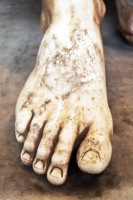Atrophy
Origin
Late Latin atrophia, from Greek, from atrophos ill fed, from a- + trephein to nourish
Definitions
- 1: decrease in size or wasting away of a body part or tissue; also : arrested development or loss of a part or organ incidental to the normal development or life of an animal or plant
- 2: a wasting away or progressive decline <was not a solitude of atrophy, of negation, but of perpetual flowering — Willa Cather>
Description
Atrophy is the partial or complete wasting away of a part of the body. Causes of atrophy include mutations (which can destroy the gene to build up the organ), poor nourishment, poor circulation, loss of hormonal support, loss of nerve supply to the target organ, excessive amount of apoptosis of cells, and disuse or lack of exercise or disease intrinsic to the tissue itself. Hormonal and nerve inputs that maintain an organ or body part are referred to as trophic [noun] in medical practice ('trophic" is an adjective that can be paired with various nouns). Trophic describes the trophic condition of tissue. A diminished muscular trophic is designated as atrophy.
Atrophy is the general physiological process of reabsorption and breakdown of tissues, involving apoptosis on a cellular level. When it occurs as a result of disease or loss of trophic support due to other disease, it is termed pathological atrophy, although it can be a part of normal body development and homeostasis as well.[1]
